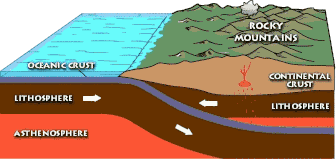Laramide orogeny
The Laramide orogeny was a time of mountain building in western North America. It started in the Upper Cretaceous, 70 to 80 million years ago. It ended 35 to 55 million years ago.

The Laramide orogeny was caused by subduction of a plate at a shallow angle.
The Laramide orogeny occurred in a series of pulses, with quiet phases in between. The main feature was a deep-seated orogeny, from Canada to northern Mexico. The easternmost mountain-building is the Black Hills of South Dakota.
When Pangaea broke up, the Americas moved West. The buckling effect of this was the Andes and the Rockies. They over-rode existing continental plates and buckled up to produce the mountain ranges on the west of the Americas.[1]
References
This article is issued from Wikipedia. The text is licensed under Creative Commons - Attribution - Sharealike. Additional terms may apply for the media files.